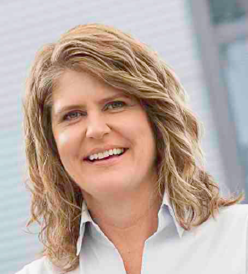When Shelley McKinley visited the Iowa State Fair this year, she made sure to swing by the food vendors.
“It was awesome. I loved it. I got a big huge bucket of those cookies to take home with me,” McKinley said, laughing.
Home for McKinley is Redmond, Wash., where she serves as the head of technology and corporate responsibility at Microsoft. This August was her first trip to the famous Iowa State Fair ― and Microsoft’s first year establishing a company presence within the Varied Industries Building to promote the Airband Initiative, a partnership between Microsoft and a network of national internet service providers to invest in and support rural internet access infrastructure.
Microsoft relaunched its broadband outreach programs from the last decade as Airband in 2017, and aims to cover 3 million Americans with broadband options across rural areas by 2022.
“The focus of the initiative is connecting the unconnected,” McKinley said. “We are working with them to help them be more effective and cover more people. … We have been helping to drive the cost of some alternative technologies for covering people down.
“With all of the efforts over the course of the last decade to get it done, and all of the money that’s been spent trying to get it done, we just haven’t made the progress. It clearly needs to be a key national priority,” she added.
The data question
Right before caucus season, nothing has a national stage like the Iowa State Fair ― so Microsoft leadership decided it was time to pack bags and be on the ground to meet the Iowans, politicians and reporters flocking to Des Moines’ east side in early August.
“A lot of the candidates are talking about broadband, so it’s important for us to continue to keep the pressure on the candidates to address this as an urgent national priority,” McKinley said.
Iowa has a big stake in understanding the state’s own accessibility problem, she added.
“There’s a big debate going on right now about the fidelity of the data that’s being released by the [Federal Communications Commission] on coverage,” McKinley said. “Washington, D.C., and the FCC would have people in Iowa thinking that 93.5% of Iowa is covered with broadband, which means [Iowans] can get access to it. What our Microsoft shows is that only about 30% of people living in Iowa actually access the internet at broadband speed.
“That’s because the data that’s reported by the FCC is so poor. So how do you solve a problem that you don’t understand is the first thing ― what disadvantages Iowans even more … is this is the numbers the FCC uses to allocate federal funding,” she added. “The rest of the country, on a national average ― the data is still significantly off between FCC numbers and our numbers, but it’s generally about 50%. What that tells me is that Iowa has even more significant over-reporting of access than other states.”
That puts Iowa at risk of losing limited federal funding toward broadband access projects.
The problem with the FCC’s data is “pretty well understood,” McKinley said: The FCC asks internet service providers to self-report whether, at a census block level, any households is currently accessing or could access broadband services from the provider.
“It’s a compound question to start, and there’s no differences on whether [households] are or whether they could” receive services, McKinley said. “There’s no real good definition on what that could mean. … And fundamentally, if one person in a census block [receives services], then everyone’s considered covered.”
Risk for Iowa
The state is advertising itself as an innovative center for advancements in technology, business and agriculture, but McKinley believes the state will lose desirability if the underlying broadband questions aren’t addressed over time.
“Iowa is at a big risk of losing that competitive advantage if people in Iowa aren’t able to access 21st-century technology,” McKinley said. “Whether it’s the technology innovation itself, or whether it’s innovation that’s being fueled by technology ― in order to get access to 21st-century technology and tools, everything is moving to the cloud over the internet. Iowa is losing access to that.
“I think it’s still too far under the radar. I think people still don’t understand how significant the problem is,” she added. “As someone who is working on this, I’m still surprised when I talk to people at how many people are impacted by this on a daily basis.”
Several candidates vying for the Democratic presidential nomination have offered versions of plans to address broadband inequity, but too many are heavily focused on fiber-to-the-home access models ― a model that has proved to be too expensive with relatively little impact, McKinley said.
A study done with the Boston Consulting Group in 2017 found a national deployment strategy for all-fiber infrastructure would cost about $60 billion; a mix of technology strategies could lower the cost to between $8 billion and $15 billion.
“I think fiber is a great solution for many places. It’s not a solution for everywhere because it’s very expensive to offer fiber to the last mile,” McKinley clarified. “Fixed wireless networks are much less expensive and faster to deploy. So there’s always going to be a mix … of technology so that the technology is the right technology to get to an area.”
In Iowa, Microsoft will continue working on a yet-to-be-announced partnership McKinley said would bring the Airband Initiative to most Iowa counties ― to be announced in the next few months, she added.
“We continue to work, certainly, to get the FCC to adopt more favorable rules for broadband, to really spark broadband access in many areas,” McKinley said. “We’ll continue to think about how do we best hear and access people so we can understand the challenges on the ground. I don’t know if we’ll be at any other state fairs in the coming months, but it’s a possibility.”
